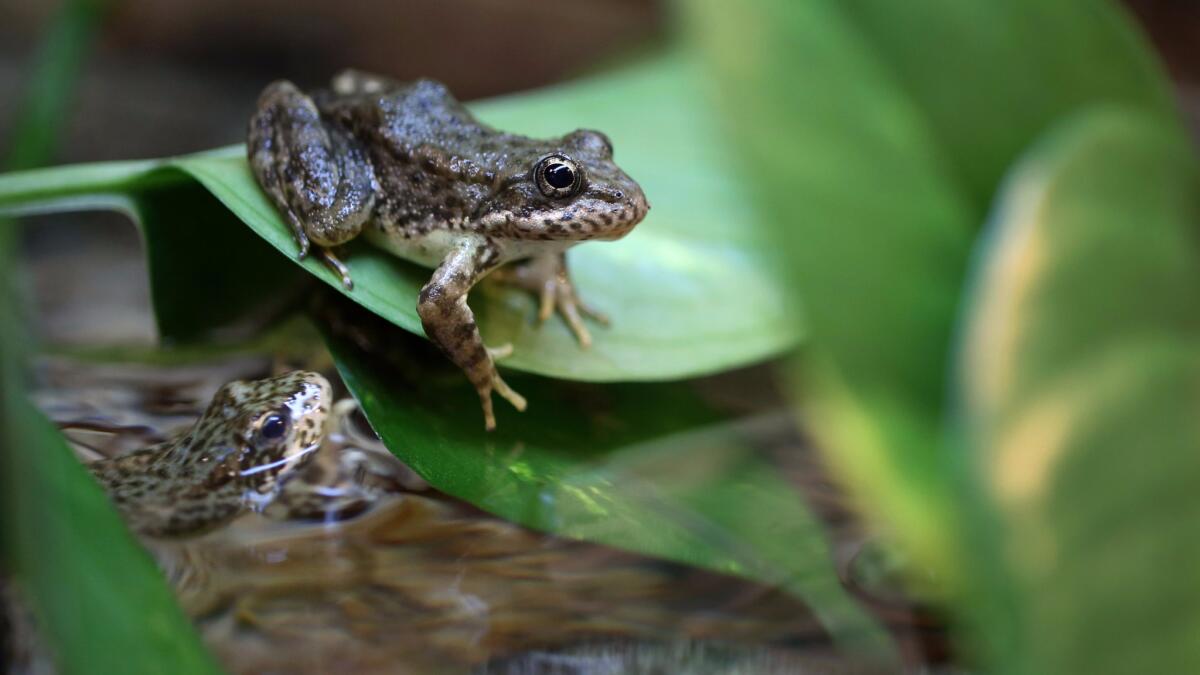Drought and wildfires threaten the endangered mountain yellow-legged frog

A half-century ago, hundreds of streams cascading down the San Gabriel, San Bernardino and San Jacinto mountains were packed with fist-sized mountain yellow-legged frogs competing for mating rights.
Today, fewer than 400 of the federally endangered frogs are holed up in five hard-to-reach streams, all of them reduced to ribbons of shrinking ponds after five years of drought.
Now, as the third major wildfire in a month strips slopes overlooking the frogs’ ancestral habitats of vegetation, there is mounting concern that winter storms could inundate their last outposts with mud, debris and ash.
“I’ve never seen things this dry here before,” Adam Backlin, a U.S. Geological Survey biologist, said on Wednesday as he surveyed the health of a small population of about 20 frogs in the upper reaches of the San Gabriel Mountains’ Big Rock Creek. “The last thing these frogs need is drought and wildfire.”
Wildfire is a natural ecological phenomenon, biologists say. Decades ago, when yellow-legged frogs and other rare aquatic species were widespread, they survived over time by recolonizing from neighboring populations.
Not anymore. Existing populations are descendants of a species pushed to the edge of extinction by urbanization, disease and the appetites of voracious nonnative predators including crayfish, bullfrogs and trout.
Small, isolated mountain yellow-legged frog populations were lost in the aftermath of the Old fire in 2003, the Station fire in 2009 and the Mountain fire in 2013, Backlin said.
Three weeks ago, biologists watched with mounting alarm as the Sand fire ravaged 40,000 acres of northwestern San Gabriel Mountain watershed including portions of Soledad Canyon, home to rare arroyo toads and an isolated population of federally endangered unarmored threespine stickleback fish.
This week, the Blue Cut fire charred more than 37,000 acres on the range’s rugged northeastern canyon lands.
The big question now is whether it is too late to leave the unique Southern California frog’s fate to nature.
In 2010, federal wildlife authorities launched an ambitious recovery program that includes captive breeding facilities, trout removal programs and barring public access to areas where frogs are clinging to existence.
The species’ last hope may be swimming in carefully monitored aquariums at the Los Angeles Zoo and the San Diego Zoo, where genetic “insurance colonies” are being raised in collaboration with the U.S. Fish and Wildlife Service.
Three additional zoos may join the captive breeding effort later this year: the Henry Doorly Zoo in Omaha, Neb., the Memphis Zoo in Memphis, Tenn., and the Santa Ana Zoo.
At the Los Angeles Zoo, curator Ian Recchio is raising 23 mountain yellow-legged frogs that arrived three years ago as tadpoles collected in Big Rock Canyon and Little Rock Canyon.
“There’s no room for error when it comes to taking care of these frogs,” Recchio said, peering through the glass of an enclosure designed to replicate the water chemistry and seasonal shifts in temperatures and light found in the species’ natural mountain habitat.
In another year, they’ll be sexually mature and, if all goes according to plan, breeding a new generation of what Recchio described as “the rarest and most at-risk native amphibian at the zoo.”
When those tadpoles are large enough to have a shot at surviving the wild, they may be used to replenish the streams they evolved in, including the San Gabriel Mountains’ Big Rock Canyon.
More to Read
Sign up for Essential California
The most important California stories and recommendations in your inbox every morning.
You may occasionally receive promotional content from the Los Angeles Times.











